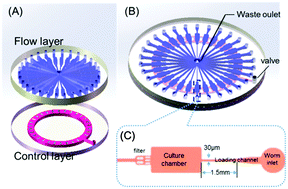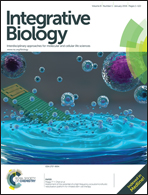Modeling type 2 diabetes-like hyperglycemia in C. elegans on a microdevice†
Abstract
Caenorhabditis elegans (C. elegans) has been widely used as a model organism for biomedical research due to its sufficient homology with mammals at the molecular and genomic levels. In this work, we describe a microfluidic assay to model type 2 diabetes-like hyperglycemia in C. elegans to examine several aspects of this disease on a microdevice. The microdevice is characterized by the integration of long-term worm culture, worm immobilization, and precise chemical stimuli in a single device, thus enabling the multi-parameter analysis of individual worms at a single-animal resolution. With this device, the lifespan, oxidative stress responses, and lipid metabolism of individual worms in response to different glucose concentrations were characterized. It was found that the mean lifespan of worms was significantly reduced by as much as 29.0% and 30.8% in worms that were subjected to 100 mM and 200 mM glucose, respectively. The expression of oxidative stress protein gst-4 was increased, and the expression of hsp-70 (heat shock protein) and skn-1 (redox sensitive transcription factor) genes was down-regulated in worms treated with a high level of glucose. Moreover, fat storage was markedly increased in the bodies of VS29 worms (vha-6p::GFP::dgat-2) that were exposed to the high-glucose condition. The established approach is not only suitable for further elucidation of the mechanism of metabolic disorders involved in diabetes and its complications, but also facilitates the evaluation of anti-diabetic drugs in a high-throughput manner.


 Please wait while we load your content...
Please wait while we load your content...